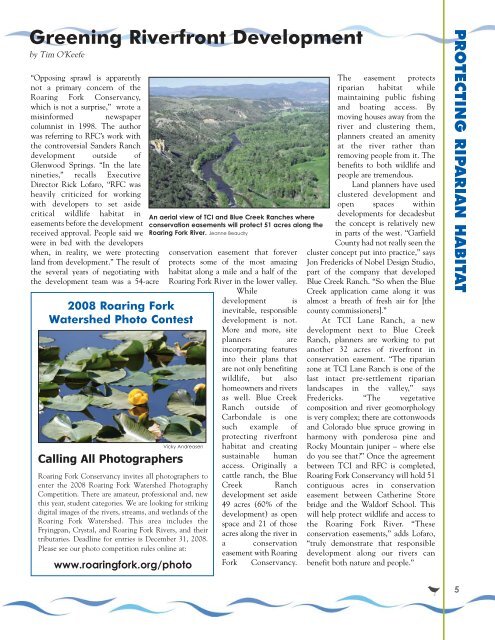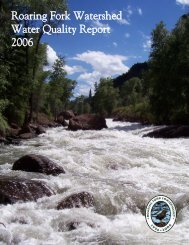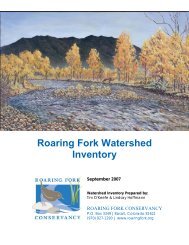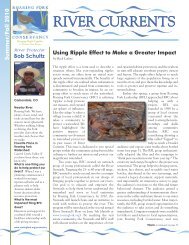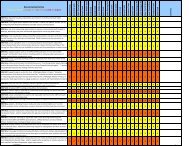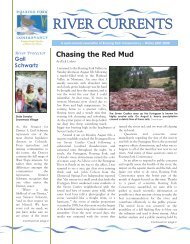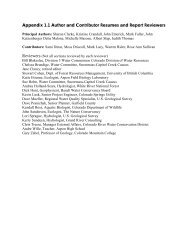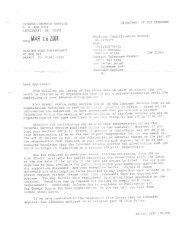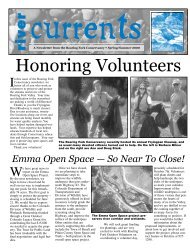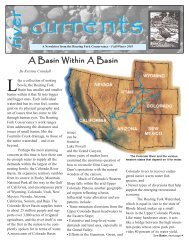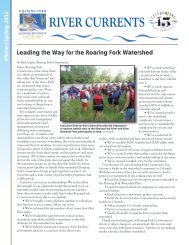New Winter 2008 Newsletter:Newsletter.qxd - Roaring Fork ...
New Winter 2008 Newsletter:Newsletter.qxd - Roaring Fork ...
New Winter 2008 Newsletter:Newsletter.qxd - Roaring Fork ...
Create successful ePaper yourself
Turn your PDF publications into a flip-book with our unique Google optimized e-Paper software.
Greening Riverfront Development<br />
by Tim O’Keefe<br />
“Opposing sprawl is apparently<br />
not a primary concern of the<br />
<strong>Roaring</strong> <strong>Fork</strong> Conservancy,<br />
which is not a surprise,” wrote a<br />
mis informed newspaper<br />
columnist in 1998. The author<br />
was referring to RFC’s work with<br />
the controversial Sanders Ranch<br />
development outside of<br />
Glenwood Springs. “In the late<br />
nineties,” recalls Executive<br />
Director Rick Lofaro, “RFC was<br />
heavily criticized for working<br />
with developers to set aside<br />
critical wildlife habitat in<br />
easements before the development<br />
received approval. People said we<br />
were in bed with the developers<br />
when, in reality, we were protecting<br />
land from development.” The result of<br />
the several years of negotiating with<br />
the development team was a 54-acre<br />
<strong>2008</strong> <strong>Roaring</strong> <strong>Fork</strong><br />
Watershed Photo Contest<br />
Calling All Photographers<br />
<strong>Roaring</strong> <strong>Fork</strong> Conservancy invites all photographers to<br />
enter the <strong>2008</strong> <strong>Roaring</strong> <strong>Fork</strong> Watershed Photography<br />
Competition. There are amateur, professional and, new<br />
this year, student categories. We are looking for striking<br />
digital images of the rivers, streams, and wetlands of the<br />
<strong>Roaring</strong> <strong>Fork</strong> Watershed. This area includes the<br />
Fryingpan, Crystal, and <strong>Roaring</strong> <strong>Fork</strong> Rivers, and their<br />
tributaries. Deadline for entries is December 31, <strong>2008</strong>.<br />
Please see our photo competition rules online at:<br />
www.roaringfork.org/photo<br />
An aerial view of TCI and Blue Creek Ranches where<br />
conservation easements will protect 51 acres along the<br />
<strong>Roaring</strong> <strong>Fork</strong> River. Jeanne Beaudry<br />
conservation easement that forever<br />
protects some of the most amazing<br />
habitat along a mile and a half of the<br />
<strong>Roaring</strong> <strong>Fork</strong> River in the lower valley.<br />
While<br />
Vicky Andreasen<br />
development is<br />
inevitable, responsible<br />
development is not.<br />
More and more, site<br />
planners are<br />
incorporating features<br />
into their plans that<br />
are not only benefiting<br />
wildlife, but also<br />
homeowners and rivers<br />
as well. Blue Creek<br />
Ranch outside of<br />
Carbondale is one<br />
such example of<br />
protecting riverfront<br />
habitat and creating<br />
sustainable human<br />
access. Originally a<br />
cattle ranch, the Blue<br />
Creek Ranch<br />
development set aside<br />
49 acres (60% of the<br />
development) as open<br />
space and 21 of those<br />
acres along the river in<br />
a conservation<br />
easement with <strong>Roaring</strong><br />
<strong>Fork</strong> Conservancy.<br />
The easement protects<br />
riparian habitat while<br />
maintaining public fishing<br />
and boating access. By<br />
moving houses away from the<br />
river and clustering them,<br />
planners created an amenity<br />
at the river rather than<br />
removing people from it. The<br />
benefits to both wildlife and<br />
people are tremendous.<br />
Land planners have used<br />
clustered development and<br />
open spaces within<br />
developments for decadesbut<br />
the concept is relatively new<br />
in parts of the west. “Garfield<br />
County had not really seen the<br />
cluster concept put into practice,” says<br />
Jon Fredericks of Nobel Design Studio,<br />
part of the company that developed<br />
Blue Creek Ranch. “So when the Blue<br />
Creek application came along it was<br />
almost a breath of fresh air for [the<br />
county commissioners].”<br />
At TCI Lane Ranch, a new<br />
development next to Blue Creek<br />
Ranch, planners are working to put<br />
another 32 acres of riverfront in<br />
conservation easement. “The riparian<br />
zone at TCI Lane Ranch is one of the<br />
last intact pre-settlement riparian<br />
landscapes in the valley,” says<br />
Fredericks. “The vegetative<br />
composition and river geomorphology<br />
is very complex; there are cottonwoods<br />
and Colorado blue spruce growing in<br />
harmony with ponderosa pine and<br />
Rocky Mountain juniper – where else<br />
do you see that?” Once the agreement<br />
between TCI and RFC is completed,<br />
<strong>Roaring</strong> <strong>Fork</strong> Conservancy will hold 51<br />
contiguous acres in conservation<br />
easement between Catherine Store<br />
bridge and the Waldorf School. This<br />
will help protect wildlife and access to<br />
the <strong>Roaring</strong> <strong>Fork</strong> River. “These<br />
conservation easements,” adds Lofaro,<br />
“truly demonstrate that responsible<br />
development along our rivers can<br />
benefit both nature and people.”<br />
5PROTECTING RIPARIAN HABITAT


